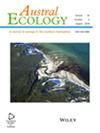在墨西哥干燥的热带森林中,被金龟子Canthon cyanellus (LeConte, 1859)侵食的线刺蛛(Aspidoscelis lineattissimus, Cope, 1878)和被金龟子Incilius marmoreus (Wiegmann, 1833)
IF 1.6
4区 环境科学与生态学
Q3 ECOLOGY
引用次数: 0
摘要
无脊椎动物和中小型脊椎动物的尸体是尸食性甲虫的主要食物来源;然而,这些甲虫对疱疹动物尸体的消耗知之甚少。在本文中,我们首次报道了墨西哥Chamela-Cuixmala生物圈保护区中蜥蜴Aspidoscelis lineattissimus (Teiidae)和蟾蜍Incilius marmoreus (Bufonidae)的尸体被屎壳郎Canthon cyanellus(金龟子科)吃掉。我们的报告表明,两栖动物和爬行动物的尸体可能与热带森林中腐肉甲虫的繁殖和摄食行为有关。本文章由计算机程序翻译,如有差异,请以英文原文为准。

Necrophagy in Aspidoscelis lineattissimus (Cope, 1878) and Incilius marmoreus (Wiegmann, 1833) by the Dung Beetle Canthon cyanellus (LeConte, 1859) in a Dry Tropical Forest of Mexico
The carcasses of invertebrates and small to medium-sized vertebrates are the main food source of necrophagous beetles; however, little is known about the consumption of herpetozoan carcasses by these beetles. In this note, we present the first reports of the consumption of a carcass of a lizard, Aspidoscelis lineattissimus (Teiidae) and a carcass of a toad, Incilius marmoreus (Bufonidae) by the dung beetle Canthon cyanellus (Scarabaeidae) in the Chamela-Cuixmala Biosphere Reserve, Mexico. Our reports suggest that amphibian and reptile carcasses may be relevant to the reproduction and feeding behaviours of carrion beetles in tropical forests.
求助全文
通过发布文献求助,成功后即可免费获取论文全文。
去求助
来源期刊

Austral Ecology
环境科学-生态学
CiteScore
2.90
自引率
6.70%
发文量
117
审稿时长
12-24 weeks
期刊介绍:
Austral Ecology is the premier journal for basic and applied ecology in the Southern Hemisphere. As the official Journal of The Ecological Society of Australia (ESA), Austral Ecology addresses the commonality between ecosystems in Australia and many parts of southern Africa, South America, New Zealand and Oceania. For example many species in the unique biotas of these regions share common Gondwana ancestors. ESA''s aim is to publish innovative research to encourage the sharing of information and experiences that enrich the understanding of the ecology of the Southern Hemisphere.
Austral Ecology involves an editorial board with representatives from Australia, South Africa, New Zealand, Brazil and Argentina. These representatives provide expert opinions, access to qualified reviewers and act as a focus for attracting a wide range of contributions from countries across the region.
Austral Ecology publishes original papers describing experimental, observational or theoretical studies on terrestrial, marine or freshwater systems, which are considered without taxonomic bias. Special thematic issues are published regularly, including symposia on the ecology of estuaries and soft sediment habitats, freshwater systems and coral reef fish.
 求助内容:
求助内容: 应助结果提醒方式:
应助结果提醒方式:


